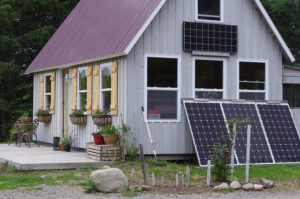
Saint John and St. Andrews — Have you wondered what you can do to lessen your home’s carbon footprint? Would you like to learn more about the options available to you and the practical steps you can take to make a real difference? Here is your chance to see what homeowners in your community are doing to live sustainably.
You can get inspired and find out what innovative homeowners are doing in your neighborhood by signing up to participate in our Passport to a Low Carbon Future EcoHomes Tour scheduled for June 9 in southwestern New Brunswick. Find the event on Facebook here.
Organized by dedicated volunteers from the Conservation Council of New Brunswick and the Saint John chapter of the Council of Canadians, the tour will shine a spotlight on low carbon homes and public buildings in Bocabec, St. George, Saint John, Quispamsis and the Kingston Peninsula.
Spots along the eco tour include stops at:
- an off-the-grid artist’s cabin in the woods;
- a home built in the 50’s where the owners installed a solar hot water heating system in the ‘80s — talk about an early adopter;
- the Terra Berma project, which demonstrates sustainable off-grid living, with rammed earth construction, solar and wind power, green roof, and a permaculture garden;
- a timber frame, passive solar, straw wall, earth berm home with sod roof;
- a small footprint passive solar and solar off-grid home;
- a LEED Gold Certified building at the Saint John Campus of the University of New Brunswick;
- a large recreational complex with innovative heating, cooling, daylight sensors and waterless urinals in Quispamsis;
- the Rossmount Inn, an 18-room inn complete with fine dining restaurant which uses solar energy for hot water heating and heating an office during the winter months, and also has an electric vehicle charging station for guests;
- the First Certified CHBA Net Zero Home in NB;
- a completely off-grid stone home and boatbuilding workshop;
- Crooked Creek off-grid home and hobby farm; and,
- A grid connected salt box super energy efficient home with passive solar, a solarium, masonry heater, radiant heat, earth berming and R2000 insulation.
After the tour, we invite you to join us for a chance to meet and greet and share information and light refreshments starting at 5 p.m. at the fabulous Elmhurst Outdoors at 65 Ganong Road on the Kingston Peninsula.
“The tour is a great way to showcase low-carbon homes and public buildings that already exist in our communities, and learn from these fabulous owners,” says Eco Tour organizer Liane Thibodeau. “The generosity the hosts are showing us — with their open doors and personal commitment — speaks volumes to us about how much we can and are building sustainable communities.”
The tour is free and organizers are arranging for carpooling — using electric and hybrid cars as much as possible.
The Conservation Council recommends that you mark June 9 in your calendar now and “like” the tour’s Facebook page (link) to get regular updates and more information of each special tour stop.
-30-
Quotes
“We designed our off-grid home and hobby farm ourselves to suit our desire to live in the country in an as environmentally friendly fashion as possible. The property we purchased was a fair distance from the grid which was both a motivation and a challenge for us to prove that living off-grid was very doable, not overly costly and would not impose undue inconveniences on us or on any of our frequent overnight guests – our kids and grandkids!“
Homeowners Kate and Peeter Vihvelin
“What makes us most proud is that this late 1980s house, was conceived and built in the time before climate change was generally even known about. Yet when we were reflecting about the house features for this “footprint” tour, we realized that we had done almost everything right in building a house for a future world 30 years later, dominated by the huge environmental effects of greenhouse gases.”
Homeowners Brian and Lee-Ann Frost
“In 1989 I purchased 20 acres of fairly remote woodland property on the Kingston Peninsula. I didn’t have much money and I decided to try to incur as little debt as possible – a pay as I go motto. The notion of creating what little power I needed was attractive to me both in an economic sense and an environmental sense. My cabin is my biggest work of art or project I’ve worked on …more time and effort has gone into this thing than any number of paintings or art shows. I regard this as my largest work. The cabin has become a kind of living sculpture – an evolving aesthetic and is very much still a work in progress.”
Homeowner Glenn Hall
To arrange an interview, contact:
Jon MacNeill, Communications Director | 458-8747 (office) | 238-3539 (mobile) | jon.macneill@conservationcouncil.ca
